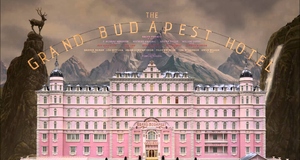From Elon Journal of Undergraduate Research in Communications VOL. 5 NO. 1Film Production Design: Case Study of The Great GatsbyAnother great set decoration choice Martin made for the party scenes (see Figure 2) were the inflatable zebras in the pool. While inflatable zebras may seem out of place at a party, she did this in order to add “eye-popping stripes” and more “verve” to the scene (Mason, 2013). While even Leonardo Di Caprio questioned the zebra’s historical accuracy, Martin had research to prove they did in fact exist at the time. Similarly, the translucent balloons helped depict the “carnival kaleidoscope” atmosphere of Gatsby’s lavish and extravagant parties. Though these elements may not stand out to the average viewer, the party would be incredibly less exciting without them. Martin’s attention to detail and ability to exaggerate while staying true to the time is quite impressive. Representation of CharacterWhen asked how production design is essential to the story of The Great Gatsby, production designer Martin says, “Just as the music plays a key role in establishing the tone, the sets are central to establishing character and showing the inner world in an outer way” (Goldfarb, 2013). The sets of The Great Gatsby are crucial in distinguishing characters from one another by emphasizing their individual personalities and status. Through production design, the characters in the film are represented in two prominent ways, such as new money versus old money and the hollowness of the upper class. New money versus old moneyJay Gatsby’s character longed for wealth and sophistication ever since he was a boy. This longing intensified after meeting his love, Daisy Buchanan, who lived this life of luxury. It is no surprise that when Gatsby eventually became a wealthy man, he glitzed and glamorized every aspect of his home. Martin says, “The Buchanans were unbelievably wealthy. We needed to make Gatsby’s wealth feel competitive, because in Gatsby’s heart he has always believed that the reason he didn’t get Daisy was because he was poor” (Yang, n.d.). Gatsby’s character represents a man indulging in new money and uncontrollably spending. Daisy’s character represents someone from old money that is comfortable and more conservative with her wealth. The production design of Gatsby’s extravagant mansion (see Figure 3) compared to the production design of the Buchanan’s luxurious Georgian manor (see Figure 4) perfectly distinguishes the idea of new money versus old money. The exterior of Gatsby’s home, St. Patrick’s Seminary in Sydney, provides an ostentatious feel of Gothic revival. Catherine Martin explains, “You get this sense of excess — of someone overreaching. This is conveyed in the Neo-Gothic style of Gatsby’s house, the almost Versailles-sized fountain in the front” (Miller, 2013). The massive fountain outside Gatsby’s home symbolizes his over exaggeration of wealth upon arrival. While there are touches of classic Art Deco, it is clear Gatsby’s home is over-the-top. Daisy’s beautiful brick home represents a pristine and calmer view of wealth. Martin says, “Then you go to the Buchanans’, which is described in the book as an enormous pile of red bricks, and it is a much quieter view of wealth.” (Miller, 2013). Daisy’s home is excessive, yet tasteful and classic. The difference between new money and old money is also seen in the production design of Gatsby’s foyer (see Figure 5) compared to Daisy’s living room. Martin perfectly created Gatsby’s mansion to represent his gaudy and ostentatious attitude as well as reflect his lack of social grace. Martin says, “We talked about somebody coming in with a lot of money and what changes he would make to certain rooms” (Goldfarb, 2013). Gatsby’s foyer is equipped with a gold-filigreed ceiling with multiple ornate chandeliers, massive towering columns between large windows, a serpentine staircase, and, the most overstated, a marquetry floor with an oversized monogram in the center. Martin created Gatsby’s grand staircase based on the staircase in La Selva, an Italian villa built in the teens (Keeps, 2013). The staircase is an element of the room Martin believes Gatsby would have added himself. Its overwhelming and flamboyant nature completely takes over the space. The Buchanan’s living room on the other hand is much more elegant. It is clear from this space that Daisy created a beautiful, yet functional and homey room to both live and entertain. Martin furnished their home in a more eclectic way using antiques that “look as though it could have been passed down in the family for 300 years” (Miller, 2013). While it is clear that the Buchanan’s have nice things, they are less flashy and up to date as Gatsby’s home. The room is small and has a Hollywood Regency and Deco-inflected feel (see Figure 6). The furnishings, contemporary art, and long vertical windows overlooking the formal gardens are perfectly sophisticated yet understated. Martin explains these elements of the room are intended to “contrast Daisy with the new-money fantasist that is Gatsby” (Goldfarb, 2013). The hollowness of upper classA popular theme in Fitzgerald’s The Great Gatsby is the idea of the hollowness of the upper class. The novel portrays the newly rich as vulgar and disgraceful, while those with old money as fickle and selfish. Martin displays this idea through production design in the film. While the characters of the upper class live in massive mansions with high ceilings and cold marble floors, the characters with less status live in comfortable, cozy cottages and apartments. Nick Carraway is a character that perfectly contrasts Gatsby’s personality and status. He is a content young man trying to make his way in the business world. His rented homey cottage reflects his quiet, trustworthy, and tolerant personality. The cottage Martin created for Nick offers instant comfort and warmth. It is easy to understand why Gatsby and Daisy trust Nick throughout the story after seeing his modest home (see Figure 7). The beautiful archway adorned with white flowers is instantly welcoming juxtaposed with the round tree bench as well as his well-kept lawn and garden. Nick’s living room (see Figure 8) is enclosed with low ceilings and quarter sawn oak beams. The room is filled with Stickley-esque furniture and moss green tiles that surround the heart of the fireplace (Goldfarb, 2013). The green tiles and accents throughout the room, combined with the oak furniture and beams, create a feeling of nature and purity. Martin says, “It was all about finding what we thought were quintessential Long Island motifs” (Heisner, 2011, p. 2). The small nature of the house with the intimate atmosphere of the individual rooms creates a content space that reflects Nick’s personality. Similarly, Myrtle Wilson’s chaotic apartment (see Figure 9 below) above Wilson’s Garage (see Figure 10) gives off a welcoming vibe. Like Nick’s living room, the warm red and pink colors could make anyone feel at home. The walls, shelves, and tables are all cluttered with eclectic frames, vases, and trinkets that represent Myrtle carefree personality. The amount of frames and photographs allude to the idea Myrtle has a strong family background. The flowers scattered around the room make the room seem inviting. It is clear that anyone would feel welcome in this apartment from the scene in the film where Nick visits Myrtle with Tom. Martin says, “In the Fitzgerald book it says the couch is upholstered in something that looked like the 18th century painting of a girl in a swing by Fragonard. So we had that digitally printed onto the upholstery fabric” (Keeps, 2013). This is another example of how Martin successfully exaggerated and exemplified a historical element. Through the size, set decoration, and colors used in Nick’s and Myrtle’s home, Martin was able to depict the idea that a lower economic status calls for a more modest lifestyle. ConclusionAs shown in this paper, The Great Gatsby successfully proves the importance of production design in a film. Catherine Martin’s mixture of creativity and historical references brings to life the characters and era of Fitzgerald’s cherished novel. By emphasizing the Art Deco movement, exemplifying the 1920s, and representing the status and various personalities of the characters, Martin adds excitement and conflict to the film. The Art Deco elements of the production design along with the attention to 1920s style signify the carefree and wild lifestyle of the time. Similarly, the production design contrasts the main characters personalities and represents two major themes in the story: new money versus old money and the hollowness of the upper class. Without the extravagant, dynamic, and well-researched production design, The Great Gatsby film would not have been able to survive simply based on Fitzgerald’s words. AcknowledgementsThe author is grateful for Professor Don A. Grady at Elon University for his patience, guidance, and mentoring over the past semester. This article could not have been published without his inspiration and encouragement. The author is also thankful to Professor Byung Lee of Elon University for his supervision and advice during the revision of this article. ReferencesBergfelder, T., Harris, S., & Street, S. (2007). Film architecture and the transitional imagination. Amsterdam, Netherlands: Amsterdam University Press. Emile Jacques Ruhlmann. (2007, June 12). Ruhlmann. Retrieved November 3, 2013, from http://www.ruhlmann.info/contact.php/t,Co Esperdy, G. (2007). From instruction to consumption: Architecture and design in Hollywood movies of the 1930s. The Journal of American Culture, 30(3), 198-211. Goldfarb, B. (n.d.). The sets of The Great Gatsby. Architectural Digest. Retrieved November 3, 2013, from http://www.architecturaldigest.com/ad/set-design/2013/great-gatsby-film-set-design-article Heisner, B. (2011). Hollywood art: Art direction in the days of the great studio. Jefferson, NC: McFarland Press. Kenega, H. (1999). Pretty pictures: Production design and the history of film. Historical Journal of Film, Radio, and Television, 19(2), 266-267. Retrieved from http://search.proquest.com/pqrl/docview/208153804/fulltext/140D97189517DA12DF9/1?accountid=10730 Keeps, D. (2013, May 11). The houses of ‘Gatsby’: Q&A with production designer Catherine Martin. Los Angeles Times. Retrieved November 3, 2013, from http://articles.latimes.com/2013/may/11/news/la-lhgreat-gatsby-set-design-20130510 Klinggensmith, D. (2013, June 22). Getting Gatsby’s style: “The Great Gatsby” film pays homage to 20’s Art Deco movement. The Chronicle Herald. Lamster, M. (2000). Architecture and film. New York, NY: Princeton Architectural Press. Mason, M. (2013, April 28). Catherine Martin: The Great Gatsby production and costume designer spills on working with her husband. Sunday Telegraph Magazine, 1, Retrieved from http://www.nclive.org/cgibin/nclsm?url=http://search.ebscohost.com/login/aspx?direct=true&db=n5h&AN=201304281049479083&site=ehost-live Miller, J. (2013, June 7). The Great Gatsby’s Catherine Martin on designing the Jay-Z-scored party scenes (“no hip thrusting”) and Gatsby’s “pimped out” yellow convertible. Vanity Fair. Retrieved November 3, 2013, from http://www.vanityfair.com/online/oscars/2013/05/the-great-gatsby-production Neilson, C. (2013, June 5). A conversation with academy award winning set designer Catherine Martin. Arch-Daily. Retrieved November 3, 2013, from http://www.archdaily.com/381007/ Ramirez, J. (2004). Architecture for the screen: A critical study of set design in Hollywood’s golden age. Jefferson, North Carolina: McFarland Press. Tashiro, C. (2004). Passing for the past: Production design and the historical film.Cineaste, 29(2), 40-44. Retrieved from http://search.proquest.com/pqrl/docview/204854729/fulltext/140D97189517DA12DF9/4?accountid=10730 Warner Brothers Pictures. 2013. [Buchanan home]. Retrieved from http://www.architecturaldigest.com/ad/setdesign/2013/great-gatsby-film-set-design-slideshow_slideshow_item7_8 Warner Brothers Pictures. 2013. [Buchanan sitting room]. Retrieved from http://www.architecturaldigest.com/ad/set-design/2013/great-gatsby-film-set-design-slideshow_slideshow_item8_9 Warner Brothers Pictures. 2013. [Gatsby’s foyer]. Retrieved from http://www.architecturaldigest.com/ad/setdesign/2013/great-gatsby-film-set-design-slideshow_slideshow_item1_2 Warner Brothers Pictures. 2013. [Gatsby’s home]. Retrieved from http://www.architecturaldigest.com/ad/setdesign/2013/great-gatsby-film-set-design-slideshow_slideshow_item3_4. Warner Brothers Entertainment. 2013. [Gatsby’s lavish parties]. Retrieved from http://thegreatgatsby.warnerbros.com Warner Brothers Pictures. 2013. [Gatsby’s master bedroom]. Retrieved from http://www.architecturaldigest.com/ad/set-design/2013/great-gatsby-film-set-design-slideshow_slideshow_item2_3 Warner Brothers Pictures. 2013. [Myrtle’s apartment]. Retrieved from http://www.vanityfair.com/online/oscars/2013/05/the-great-gatsby-production_slideshow_item7_8 Warner Brothers Pictures. 2013. [Nick Carraway’s home]. Retrieved from http://www.architecturaldigest.com/ad/set-design/2013/great-gatsby-film-set-design-slideshow_slideshow_item5_6 Warner Brothers Pictures. 2013. [Nick Carraway’s living room]. Retrieved from http://www.architecturaldigest.com/ad/set-design/2013/great-gatsby-film-set-design-slideshow_slideshow_item6_7 Warner Brothers Pictures. 2013. [Wilson’s garage]. Retrieved from http://www.vanityfair.com/online/oscars/2013/05/the-great-gatsby-production_slideshow_item6_7 Yang, S. (n.d.). Buchanan house. House Beautiful. Retrieved November 1, 2013, from http://www.housebeautiful.com/photos/the-great-gatsby-buchanan-house#slide-5 Suggested Reading from Inquiries Journal
Inquiries Journal provides undergraduate and graduate students around the world a platform for the wide dissemination of academic work over a range of core disciplines. Representing the work of students from hundreds of institutions around the globe, Inquiries Journal's large database of academic articles is completely free. Learn more | Blog | Submit Latest in Film & Media |




























